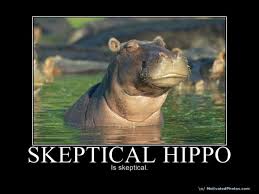For the past couple of years I’ve gotten the chance to give a talk to my brother’s high school class about how to read science you encounter “in the wild” and what types of things you should be looking out for.
The basic premise of my talk is that no matter how far you go in life in one particular subject, you will always be bombarded with science stories on Facebook and other social media that fall outside your expertise. Given that, it’s pretty critical that you have a general schema to sort through popular science reporting, and develop an idea of what to look out for.
Basically, I tell the kids that every time they see something scientific mentioned on Facebook, they should immediately look like this:
The issue, as far as I can tell, is that most of us get used to two different tracks of scientific thought: one that we encounter when we’re expecting it, and one we encounter when we’re not. When you’re sitting around waiting for a teacher to quiz you, it’s relatively easy to remember to read carefully and think critically. When you’re scrolling through Facebook or Twitter or whatever else is popular these days, it’s not so easy.
I have a lot of fun with this talk, and I’ve started to develop a general 10 point list of things the kids should keep in mind. For my next series of blog posts, I’m essentially going to blog out the different points of my talk. This will hopefully serve the dual purpose of helping me improve my points and anecdotes, and helping me go through my archives and start categorizing my old posts around these topics.
Ready? Great! Then here’s what you’re in for:
There’s four main topics, each with a few subcategories. They are:
Presentation: How They Reel You In
Pictures: Trying to Distract You
Proof: Using Numbers to Deceive
- The Anecdote Effect
- Experts and Balances
- Crazy Stats Tricks: False Positives, Failure to Replicate, Correlations, Etc
People: Our Own Worst Enemy
- Biased Interpretations and Motivated Reasoning
- Surveys and Self Reporting
- Acknowledging our Limitations
I’ll be attempting to put up one per week, but given life and all, we’ll see how it goes.
Want to go straight to Part 1? Click here. Want the wrap up with all the links? Click here.

That’s a semester-long course.
Which should be required.
LikeLike
What AVI said, along with basic accounting.
LikeLike
You know, this article looks pretty good.
[sarc]
But for some reason, I’m a little skeptical…
[/sarc]
LikeLike
Pingback: Presentation: How they Reel You In (Part 1) | graph paper diaries
Pingback: Pictures: How They Try to Distract You (Part 3) | graph paper diaries
Pingback: Presentation: How They Reel You In (Part 2) | graph paper diaries
Pingback: Pop Science and an Introduction | graph paper diaries
Pingback: Five Reasons Not to Use a Blog Post as a Reference | graph paper diaries
Pingback: Two Ways To Be Wrong – Two ways to be wrong